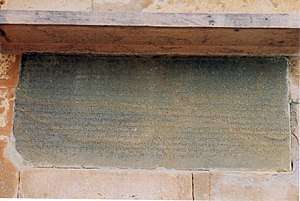Aihole inscription
Aihole in Karnataka state of South India, is known as Cradle of Indian Temple Architecture. It was the first capital of Chalukyas where they built numerous temples, the oldest dating back to the 6th century CE.

Introduction
Many inscriptions are found at Aihole, important among which is the inscription at Meguti Temple popularly known as Aihole inscription, or Aihole Prashasti (Eulogy) of the Chalukya king Pulakeshi-II. The inscription uses Sanskrit language and is written in Kannada script.[1][2] There is a mention about the defeat of King Harshavardhana by Pulikeshi II in the inscription.[3] There is also a mention about the victory of Chalukyas over the Pallavas and of the shifting the capital from Aihole to Badami by Pulikeshi-II. The poet Kalidasa finds mention in the inscription and this has helped in determining his time.
Aihole Inscription of Pulakesin II
The inscription is found at Aihole in Karnataka state, India. The Aihole inscription was written by the Ravikirti, royal poet at the court of Chalukya King, Pulakeshi II who reigned from 610 to 642 CE. The poetic verses (Shilalekh or stone inscription) of Ravikirti, in praise of the king, can be read at the Meguti temple,[4] dated 634 CE. The inscription is in the Sanskrit language, and uses Kannada script.[5][1][2]

Aihole inscription of Pulakesin II mentions his victory over Southern kingdom of Pallavas, who had attempted to prevent the rise of the Badami Chalukyas. Since the inscription has mentioned the time elapse since Mahabharata war and also the Shaka era, this inscription is also important in determining possible date of Mahabharata war.[6] The Aihole inscription refers Mangalesha's (Paramabhagavat) victory over the Kalachuris and the conquest of Revatidvipa (Present-day Redi port on Western coast of India). According to the Aihole inscription of Pulakeshin II, conflict between his own Uncle Mangalesha and Pulakeshin II, due to Mangalesa's attempt to secure the succession for his own son, resulted in ending Mangalesha's reign.[7] The inscription of Amoghavarsha I found at Aihole, mentioned his new administration (navarajyam geyye).[8]
References
- Encyclopaedia of the Hindu World, Volume 1, p.252, Gaṅgā Rām Garg, Concept Publishing Company, 1992, India, ISBN 81-7022-374-1
- Kamlesh Kapur, Sterling Publishers Pvt. Ltd, Chapter 35, The Chalukyas of Badami, Brief history of the Chalukyas, New Delhi, ISBN 978 81 207 5212 2
- "Aihole's stories in stone". Retrieved 2 May 2013.
- Project South Asia (2000–2005). "Project South Asia". South Dakota State University - Be Great. Start Here. SDSU South Dakota State University. Archived from the original on 4 February 2009. Retrieved 27 May 2012.
- Dr. Jyotsna Kamat (2 January 2012). "Inscriptions - Message with Long Life: Indian Inscriptions". Kamat's Potpourri. Kamat's Potpourri. Retrieved 27 May 2012.
- Dr. P.V.Vartak (2009–2011). "The Scientific Dating of the Mahabharat War". Library Of Hindu History. Dharma Universe. Retrieved 27 May 2012.
- Unknown. "HISTORY - EARLY CHALUKYAS". Welcome to the Gazetteers Department. Maharashtra State Gazetteers. Archived from the original on 10 April 2009. Retrieved 27 May 2012.
- Unknown. "The Indian Analyst : South Indian Inscriptions : BOMBAY-KARNATAKA INSCRIPTIONS VOLUME I - Part I". WhatIsIndia.com. What Is India Publishers (P) Ltd. Retrieved 27 May 2012.